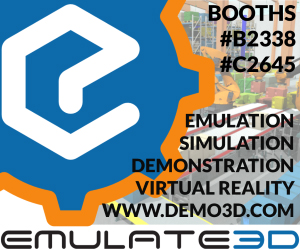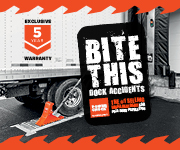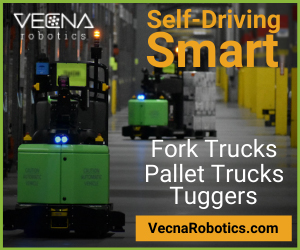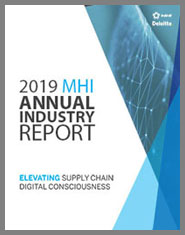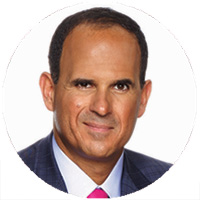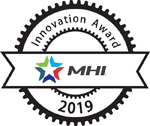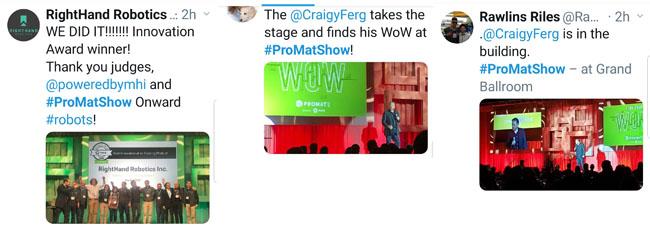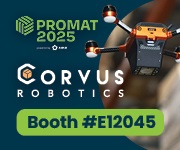 |
||||||||||||||||||||
| Archive | Printer Friendly | Send to a Friend | PROMAT Show | ||||||||||||||||||||
|
Latest Updates
If you missed any of the daily newsletters or are looking for a quick way to reference something you saw in any of them, here is the ProMat 2019 enewsletter archive.
Best of ProMat Daily
Every year, the MHI Annual Industry Report reveals some interesting and even surprising results. This year’s report – the sixth in the series – lived up that expectation. The 2019 survey results and the digital and printed versions of the report were released Wednesday morning during a session moderated by Scott Sopher, Principal with Deloitte Consulting LLP’s Supply Chain practice, and George W. Prest, CEO of MHI. “The most surprising data point we had in the survey: planned investment,” said Sopher. The survey, titled MHI 2019 Annual Industry Report—Elevating Supply Chain Digital Consciousness, revealed that after a trend of declining investment from 2015 to 2018, the 2019 numbers show a 95% increase in projected spending. That was just one of the WOW moments presented in the survey results. Eight out 10 believe the digital supply chain will become the predominant model in the next five years. Hiring qualified workers is still the biggest challenge for 65%. And artificial intelligence has 62% growth anticipated in the next five years, coming off 13% last year and 6% two years ago. We are now in the time of necessity, said panelist Randy V. Bradley, Assistant Professor of Information Systems and Supply Chain Management, Haslam College of Business, The University of Tennessee. “You can no longer sit on the sideline and let others pass you by.” Reality is finally starting to set in. If a pilot project failed or was determined to be insufficient, companies are coming back and looking at ways to be more strategic-- with the understanding that “many of these solutions are disruptive solutions… or negative in the short term,” said Bradley. They have to be willing to stay the course before they can realize value. “Technology allows us to shape the demand…instead of being reactive,” said Bradley. “It allows people to be proactive instead of reactive,” Sopher concurred. This proactiveness is apparent in a variety of industries, and Bradley mentioned some examples in the cement, beverage and agriculture fields—such as the strawberry harvester. AGROBOT is using AI to determine when strawberries are ripe for harvesting and where to cut the strawberries for best harvesting. When it comes to the workforce, “I don’t think it is about finding the talent, it is about attracting the talent,” said Bradley. One way to do that is to write a compelling job description, said panelist Annette Danek-Akey, SVP Supply Chain, Penguin Random House. And once you have them in-house, you have to get creative. “Sometimes we are not creative with our employee engagement,” said Danek-Akey, who has been actively addressing that at Penguin House with flexible work schedules, a work-availability app called Forge and other innovative ideas, some of which were shared in the latest issue of MHI Solutions (available at the MHI booth and online) in the article, “Workplace Culture That Works.” “They don’t just want an opportunity; they want to make an impact,” added Bradley about appealing to the next generation. And, no matter what the age or generation, “If you are willing to go the extra mile, you’ll get a qualified workforce,” said Danek-Akey. The first step to going the extra mile, whether related to the workforce or technology, isn’t going to happen on its own, though. “You need to dive in,” said Prest. “Take a bite of the elephant. Stick your toe in the water.” Most likely, it is not going to be successful the first time you do it. “There is going to be some gain and there is going to be some pain,” he said. Panelist Jim Liefer, CEO, Kindred AI, said all of the levels in a company need to know “the importance of moving now.” And panelist Joel Reed, CEO, IAM Robotics said, “Companies have to be careful, as they can be left behind because of the landscape changing so rapidly.” He recommended starting with the leadership, adapting a culture of experimentation and learning from your failures. As Bradley put it, it is a matter of trying to solve challenges that businesses haven’t even thought to articulate yet. • Annette Danek-Akey referenced “Workplace Culture That Works" in MHI Solutions, the current issue that is available at the MHI booth (next to The Hub). • Randy V. Bradley wrote an article, Bridging the (Generational) Talent Gap, in the current issue of MHI Solutions, and contributed to two others: The Supply Chain Shift Toward Technology--How It’s Impacting Companies’ Workforce Talent Strategies; Educating Students for Supply Chain Success. • Industry Report: MHI 2019 Annual Industry Report—Elevating Supply Chain Digital Consciousness
Invisible? Maybe. Memorable? Absolutely. Marcus Lemonis’s keynote presentation had just about everyone wondering what was going on when he started out with the question, “What’s it feel like to be invisible?”--and the stage was completely empty. “It is not a magic trick, it is how you feel,” he explained. This very memorable opening was indicative of how the rest of his presentation would progress. “Down to earth and 100% brutally honest,” as shared by MHI President Brett Wood during his introduction, was spot on. But the subject of his presentation, as shared ahead of time, was not. “We are talking about something very different than you expected,” said Lemonis. “ If you came here to learn how to improve your actual business, you came to the wrong meeting.” Business is about one thing, and one thing only, he said. It is about people. In order to perform better or invest or sell, you have to understand what motivates people and why they think the way they do. Everything in business isn’t about outsmarting someone, about winning, he said. The series of “experiments,” examples and personal experiences he had in store, impressively illustrated his point. Mike, an attendee, shared something about himself that nobody knew. Then, with Lemonis’s help, figured out how it has affected him, what it means and how overcompensation comes into play. “We do it in business when we act like we always have the answer,” explained Lemonis. “As business owners, we don’t want to tell people or employees we don’t know.” That’s overcompensation. It is our responsibility to develop our employees, though. “It is our job to make that 2.5 (out of 10) better than 2.5,” whether we like it or not. There were also three ““firm mothers’ who took the stage to illustrate the types of conversations you might be having in your own head—though Lemonis “became” an 11-year-old kid who was being reprimanded for his behavior toward a stinky, poor classmate who wanted to be friends. But, then he updated the specs and said this scenario actually represented how we might feel about someone with whom we work—someone we might wish we didn’t work with. “There is not a person in this room that doesn’t know the difference between right and wrong,” said Lemonis. “We know it, we forget it.” He asked everyone to go back to their places of work and approach the “unwanted” co-worker. Then, be honest about how you feel and accept fault. Tell this person, “It is me and not you... it is my fault.” He also asked everyone to break the habit of muscle memory—the tendency of taking prior bad experiences/relationships and casting this wide net over everyone. He said to be yourself, be vulnerable. Then, define what your purpose is and walk to work with a different perspective. Trust the process, he said. “I am asking people to trust themselves. Believe in themselves…” When you lay your head down on your pillow, are you happy with yourself? When we go to your funeral, what are they going to say about you? What do you want your legacy to be? Finally, write him an email telling him what your purpose is: marcus@marcuslemonis.com. “I want to know what it is that makes you tick. What void are you filling?”
The 2019 MHI Innovation Award winners were revealed during Industry Night. More than 108 submissions were received this year! The four finalists in each category were announced prior to the opening of the show, but the winners of the most innovative products in each category were not revealed until Wednesday night. Best Innovation of an Existing Product—RightHand Robotics: RightPick, The Piece Picking Solution Best IT Innovation—KNAPP, Inc.: redPILOT Best New Innovation—CMC srl: Pick2Pack
Prior to Craig Ferguson taking the stage, a few awards were given out at Industry Night. Young Professional Award (YPN) Outstanding Young Professionals Award Trip of a Lifetime Trip of a Lifetime #2? As for the Craig Ferguson show...
ProMat Insights
Complimentary shuttle buses will run between McCormick Place South, Level 1, and designated show hotels from April 8-11, 2019. Buses will run on designated routes every 15-20 minutes during the following hours: THURS: 7 AM - 11 AM; 2 PM - 5 PM
Bus schedules will be posted at McCormick Place South and in each hotel. The buses will pick up and drop off on Level 1 of McCormick Place South. |
||||||||||||||||||||

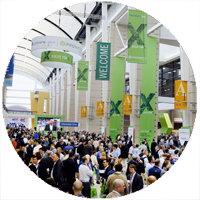 The education sessions are winding down, but the
The education sessions are winding down, but the 
